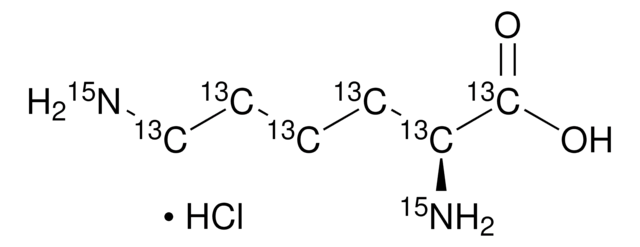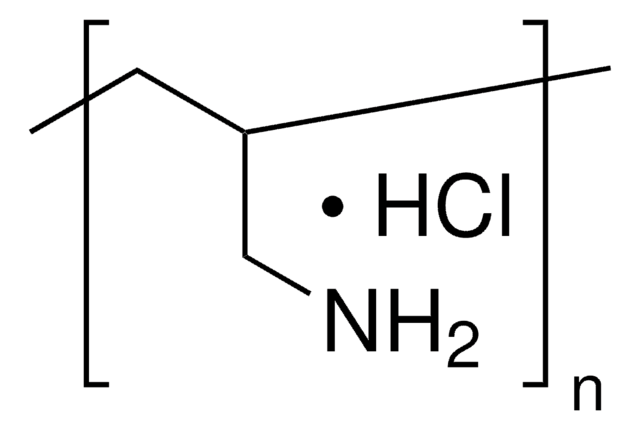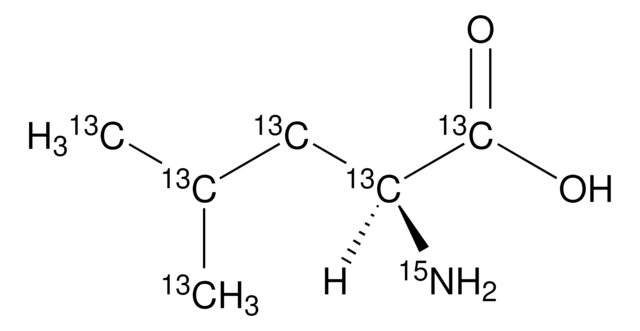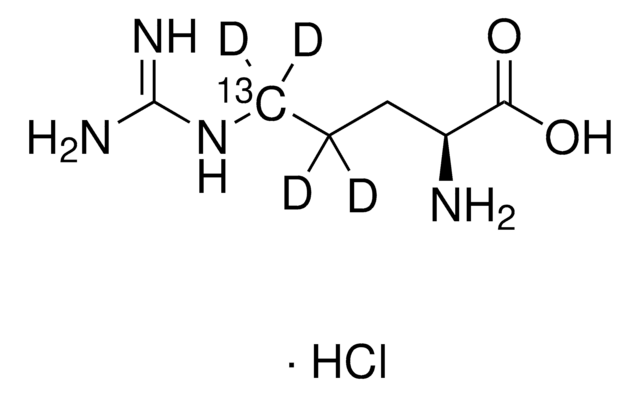608033
L-Arginine-13C6,15N4 hydrochloride
99 atom % 13C, 99 atom % 15N, 95% (CP)
Synonyme(s) :
SILAC Amino Acid, (S)-(+)-2-Amino-5-[(aminomethyl)amino]pentanoic acid-13C6,15N4 hydrochlordie, 13C and 15N Labeled ARG, 13C and 15N Labeled arginine hydrochloride
About This Item
Produits recommandés
Pureté isotopique
99 atom % 13C
99 atom % 15N
Niveau de qualité
Pureté
95% (CP)
Forme
solid
Activité optique
[α]20/D +22°, c = 12 in 10% HCl
Composition
L-isomer, 97%
Technique(s)
bio NMR: suitable
protein expression: suitable
Pf
226-230 °C (dec.) (lit.)
Changement de masse
M+10
Chaîne SMILES
Cl.[15NH2][13C@@H]([13CH2][13CH2][13CH2][15NH][13C]([15NH2])=[15NH])[13C](O)=O
InChI
1S/C6H14N4O2.ClH/c7-4(5(11)12)2-1-3-10-6(8)9;/h4H,1-3,7H2,(H,11,12)(H4,8,9,10);1H/t4-;/m0./s1/i1+1,2+1,3+1,4+1,5+1,6+1,7+1,8+1,9+1,10+1;
Clé InChI
KWTQSFXGGICVPE-YAUSPDTOSA-N
Catégories apparentées
Application
Conditionnement
Produit(s) apparenté(s)
Code de la classe de stockage
11 - Combustible Solids
Classe de danger pour l'eau (WGK)
WGK 3
Point d'éclair (°F)
Not applicable
Point d'éclair (°C)
Not applicable
Certificats d'analyse (COA)
Recherchez un Certificats d'analyse (COA) en saisissant le numéro de lot du produit. Les numéros de lot figurent sur l'étiquette du produit après les mots "Lot" ou "Batch".
Déjà en possession de ce produit ?
Retrouvez la documentation relative aux produits que vous avez récemment achetés dans la Bibliothèque de documents.
Les clients ont également consulté
Contenu apparenté
Protein structure provides valuable information that can be used to infer protein function. The study of protein structure and mapping of protein interactions, expression levels, and location enables the identification of disease biomarkers and potential drug targets for therapeutic treatment.
Notre équipe de scientifiques dispose d'une expérience dans tous les secteurs de la recherche, notamment en sciences de la vie, science des matériaux, synthèse chimique, chromatographie, analyse et dans de nombreux autres domaines..
Contacter notre Service technique











